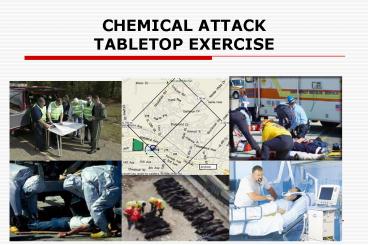CHEMICAL ATTACK TABLETOP EXERCISE PowerPoint PPT Presentation
1 / 51
Title: CHEMICAL ATTACK TABLETOP EXERCISE
1
CHEMICAL ATTACK TABLETOP EXERCISE
2
This Training is Provided to you by
- UAB South Central Center for Public Health
Preparedness - UAB Center for Labor Education and Research
3
AGENDA
- Overview of Incident Management System for Mass
Casualty Incidents - Orientation to Tabletop Exercise
- Tabletop Exercise Responding to an Attack on
Anytown, USA - Post Incident Analysis and Exercise Critique
4
- Part 1Overview of Incident Management System
- for Mass Casualty Incident Response
5
1st.Responders 1st.Recievers Public Health
Officials Face Many Challenges during Disasters
6
Hospital Emergency Incident Command System
- a medical survival plan for hospitals and
communities
7
What Is HEICS ?
- Organizational Core of Emergency Response Plan
- Organizational Chart
- Standardized Job Descriptions Checklists and
Supporting Forms - A Communication Tool
- It is a Process
8
HEICS Hierarchy
9
Basic ICS Structure
10
How Many People Can You Talk To?
- The Organizational Chart Helps to Organize
Communication - Promote Meaningful Communications
11
D
AUTHORITY
RESPONSIBILITY
ACCOUNTABILITY
12
(No Transcript)
13
Command
Safety
Liaison
Public Information
14
Operations Section
15
Operations Section
16
Planning Section
17
Logistics Section
18
Finance Section
19
What Is IMS???
- Management System for Large and Small Incidents
- Based on 5 Basic Functions
20
IMS Components
21
IMS 5 Major Functions
COMMAND
Operations
Finance
Logistics
Planning
22
COMMAND
Section
Branch
Branch
Sector / Division
Sector / Division
Sector / Division
23
(No Transcript)
24
(No Transcript)
25
Response Tools...
Status Board
Pocket Directory
Vests
26
Position Preparedness
- Identification Vest
- Job Action Sheet Clipboard/Binder
- Quick Start Sheet
27
Job Action Sheet
- One for Each Position
- Embodies Title, Mission/Function and Duties
- Adjusted to Meet Hospital Needs
28
(No Transcript)
29
Position Vests Absolutely!
- Valuable for Identification
- Valuable for Organization
30
Roles of IMS
31
HEICS Success
- ICS Used by Public Service Since Early 1980s
- HEICS Successful Exercises, Disasters Events
- HEICS Successfully Deployed in the Northridge
Earthquake (1/94) and the California Winter
Floods 95 97
32
The Unified Command Structure
33
Terminal Objective
- At the completion of this module, participants
will be able to effectively work and communicate
within an Unified Command Structure.
34
Perception Exercise
35
(No Transcript)
36
(No Transcript)
37
(No Transcript)
38
Homeland Security Presidential Directive 5
- February 28, 2003
39
What Is Unified Command
- Management System for
- Multi-Jurisdictional/Multi-Agency Incidents
- Based on 4 Basic Elements
- 1. Policies, Objectives, Strategies
- 2. Organization
- 3. Resources
- 4. Operations
40
Establishing a Unified Command
- It should be incorporated into local emergency
planning and preparedness. - Threats and risks should first be assessed in
your area and then major stakeholders identified
to be part of the unified command.
41
Unified Command Structure
Fire/EMS
Public Health
Hospitals
Operations
42
Primary Features Unified Command
- Single Integrated Incident Organization
- Shared Facilities
- Single Planning Process IAP
- Shared Planning, Logistical, Finance Sections
43
Command Post Placement
- In the cold zone
- One Base ICP
- Safe distance from hazard
- Highly visible
- Secure
- Potential target for secondary devices
44
Guidelines for Use of Unified Command
- Understand ICS Unified Command
- Share Essential Functions
- Implement at a Early Stage
- Agree on major Section Chiefs Staff Members
- Designate One IC as Spokesperson for Unified
Command Team - Train often as a Team
45
Functioning in Unified Command
- IC must be clear on jurisdictional or agency
limitations. - IC must be authorized to perform activities
actions. - IC has responsibility to manage incident to the
best of their ability. - All members of UC must function as a Team.
46
Command Meeting
- State jurisdictional/agency priorities
objectives. - Present jurisdictional limitations, concerns,
restrictions. - Develop a collective set of incident objectives
- Establish agree on acceptable priorities.
- Adopt overall strategy for objectives.
- Agree on basic organizational structure.
47
Command Meeting Cont
- Designate one Operations Section Chief
- Agree on General Staff Section procedures
- Agree on the Resource ordering process.
- Agree on cost-sharing procedures.
- Agree on informational matters.
- Designate one agency official as UC spokesperson.
48
Command Meeting Requirements
- Include only agency Incident Commanders
- Meeting should be brief and important points
documented. - Prior to meeting, officials should have reviewed
the purposes and agenda items described
previously, and be prepared to discuss them.
49
Unified Command Concept
- All stakeholders (law, fire, EMS, hospitals,
public health) or agencies (local, state,
federal) who have a functional, jurisdictional,
or legal responsibility at an incident contribute
to the process by - Determining overall response strategy and
objectives - Ensuring that joint planning for response
activities is accomplished - Ensuring that integrated operations are conducted
- Making maximum use of all assigned resources
- Resolving conflicts between the players
- Keeping track of financial costs
50
Unified Command Challenges
- Individuals must understand other agencies
concerns, responsibilities, and focus - One member of the unified command should be
selected as the overall leader - Usually represents the primary entity responsible
for operations at that time - The leadership may change as the incident evolves
51
Questions????

